For many brands, it’s tough to produce enough content. It’s a never-ending process that requires multiple team members and freelance writers. Also, there’s so much competition for the same keywords, making it a challenge to rank in search engines and attract quality traffic.
To make matters worse, freelancers sometimes use AI-powered software to generate an article instead of writing it on their own.
Does this approach impact your content rankings? Can search engines even detect AI-assisted content? This post will examine AI content detection and highlight the tools businesses can use to see if AI produced the article.
Before diving in, let’s discuss why AI content detection is a big deal at this current moment.
Check Out Our Video Guide On Top AI Content Detection Tools:
The Importance of AI Content Detection
AI is quickly becoming more commonplace with rapid advancements in technology. Also, users around the world are adopting the technology with intrigue and some hesitancy.
AI tools, like ChatGPT, make it simple for anyone to type in a query for a specific task or inquiry and generate a completed result that may be up to their satisfaction. Unlike a search engine that provides a listing of results, artificial intelligence engines like ChatGPT can provide you with answers or completed tasks based on the prompt you provide.
For example, I asked ChatGPT, “What is ChatGPT?” The following response came back:
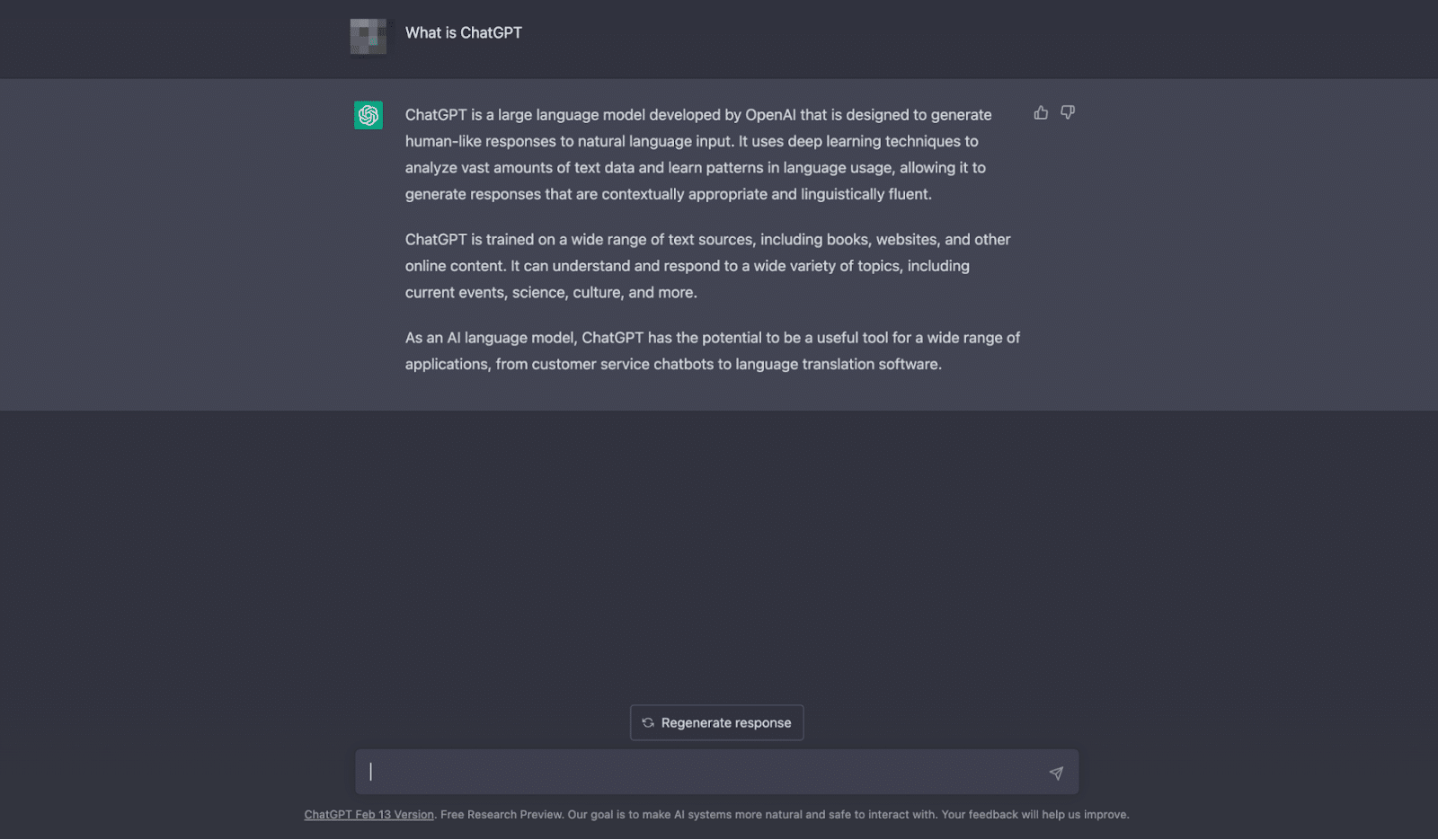
Users can ask artificial intelligence tools simple questions or instruct them to complete a task — like writing a blog post. That’s why the advancement of AI tools has proven to be a conundrum for businesses.
Copywriters, contractors, and freelance writers may try to use an AI tool for an article for a company’s blog. In fact, more than 15% of writers use an AI tool to enhance their writing.
An AI-generated article might be inaccurate, similar to everything else already posted, or even plagiarized. Businesses want to always make sure that they are publishing relevant, optimized, up-to-date content with a unique point of view.
If the company’s freelancers are using AI software to generate their posts, this could hurt the brand and waste company resources.
However, there are benefits to using AI in your business as well. In some instances, using AI may enhance an in-house staff’s content production output.
This will allow your content and digital marketing team to reallocate their resources to other areas of your SEO strategy or business. Writers who use AI can draft more blog posts at a quicker rate than those who do not use AI.
About 38% of non-AI writers believe it takes them 3-4 hours to write a post, while 38% of writers who use AI believe it takes them only 2-3 hours for the same task.

However, businesses need to look at the bigger picture and not fixate on how they can decrease costs while maximizing output. After all, AI-generated content published on your site may impact your search engine rankings.
Let’s dive deeper to see how it affects your site’s SEO performance.
Are There Penalties for Detecting AI On Your Website?
For years, content marketers have been trying to “game the system” and figure out what will perform best on Google’s algorithm.
Google considers a variety of positive and negative factors to serve its users the most accurate content for their queries. All of these factors impact a site’s SEO rankings.
Some of those factors include citation listings, domain links, mobile-first layouts, accessibility, security, keywords, meta tags, length, readability, and more.
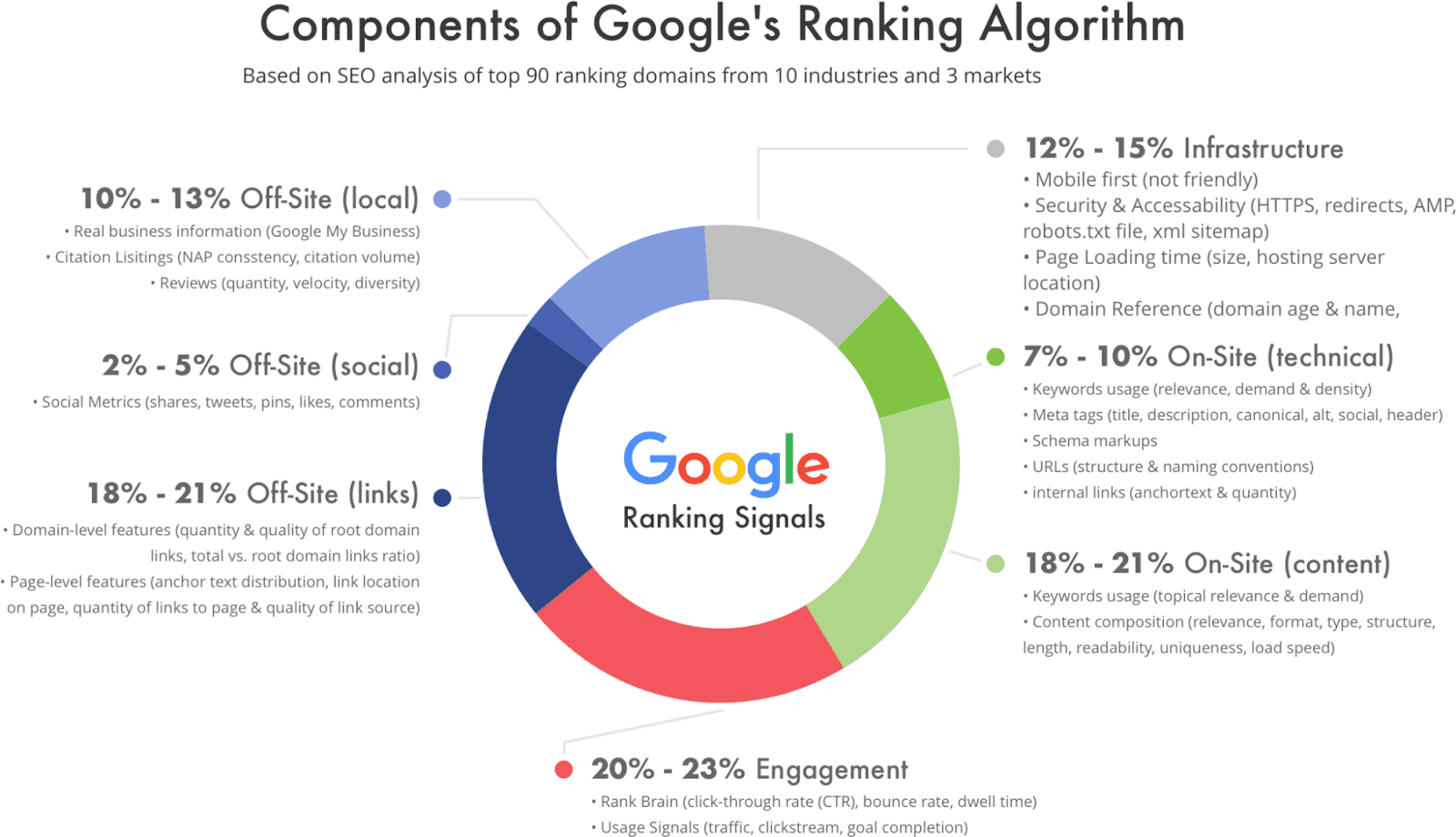
Recently, Google issued guidance on its approach to AI-generated content.
The company stated that it “focuses on the quality of the content, rather than how the content is produced.” Google pointed at its ranking and helpful content systems as two different safeguards against spammy AI-generated content.
The ranking system is in place to find and surface high-quality, original content for Google users. The recently-introduced helpful content system identifies web pages and articles that answer users’ questions, instead of surfacing optimized content.
Writers should keep both of those systems in mind while drafting their content. So must businesses who are experimenting with ways to incorporate AI-generated content into their content strategy.
Can Google Detect AI Content?
AI-generation tools are brand new and evolving quickly. How is Google able to detect AI-generated content? Are they bluffing, or did Google build something quick and accurate enough to detect AI-generated content? If there is a search engine that can holistically detect AI-generated content, it would be Google.
Although Google is secretive about its inner workings, the company is stating that it does have the ability to detect AI-generated content, and it’s warning against it.
Duy Nguyen, a member of Google’s search quality team, said, “Scraping content, even with some modification, is against our spam policy.” Duy added that Google has “many algorithms to go after such behaviors and demote site scraping content from other sites.”
Google has a variety of tools, including SpamBrain, to fight against spam on the search engine. However, Google distinguishes between AI content and spam. If the content is useful for those searching for it, Google will treat it favorably.
If the writer scraped the content or AI-generated it in a spammy way, Google may treat it negatively.
Different Ways To Detect AI-Generated Content
Sometimes, you can detect AI-generated content even without a content detection tool. There are a handful of tips and tricks that you can use to determine if AI produced an article.
With AI-generated content becoming more accessible to all writers, content marketers need to be on their toes for it at every turn. Here are some of the best ways to evaluate and determine if it’s AI-generated content:
Look for Repetitive or Unusual Patterns in the Text
Artificial intelligence isn’t perfect. Sometimes, you’ll find similar phrases in an AI-generated article. The AI might need additional learning to determine the differences between the two concepts.
For example, ChatGPT generated this paragraph about content marketing:

Although the paragraph is concise, it uses the phrase “valuable, relevant, and consistent content” twice within three sentences.
Run a Quick AI Query And Compare
Use the tools that are available to everyone. Pull up your favorite AI content generator and write a specific prompt related to your article.
Be as specific as possible about the topic, length, and structure. Click generate and see what you get as a result.
Check for Lack of Originality
Popular tools like Grammarly and Writer.com have plagiarism checkers, making it easy to see if someone has plagiarized an article. These tools will compare the content to other web content to ensure that no one has duplicated or stolen it from anything published.
Review Outdated Inaccuracies
Get your facts straight. Sometimes, artificial intelligence will insert facts from sources that are outdated or no longer relevant to the content.
Skim the article and perform some basic research on your own to make sure everything checks out.
Perform a Contextual Analysis
Humans have a far more advanced way of determining the interwoven web of concepts and ideas.
If you read the article and believe it’s missing core parts, artificial intelligence may have struggled to connect the dots in a way that a human would. This could be a sign that artificial intelligence generated it.
Use an AI Content Detector Tool
Finally, if you don’t want to do the work yourself, there are plenty of AI content detection tools on the market. AI content detection tools can determine if AI wrote the post.
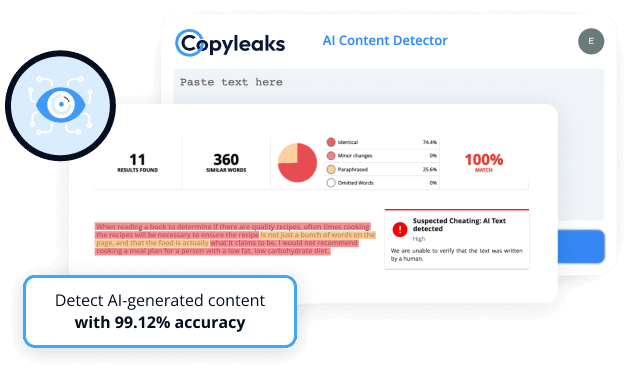
With a variety of them on the market, there is plenty for you to choose from to assess whether a human or AI-generated a specific piece of content.
But how does the AI content detection tool know if something is authentic?
How Do AI Content Detection Free Tools Work?
For many people, the world of artificial intelligence can be confusing. It’s a new technology, so everyone collectively tries to understand it in real-time. Thus, you might be thinking, how are these tools so smart? How do they know if artificial intelligence has created a piece of content?
AI content detection tools use machine learning and natural language processing to determine if a human created the content. Machine learning is a computer system that gets smarter with each query or search it executes. Natural language processing is a computer program that understands human languages.
Plus, artificial intelligence can evaluate all the information around the web for a specific content topic within seconds. This makes it capable of determining if the content is authentic or generated.
However, there are so many AI content detection-free tools on the market. Which should you use? Let’s take a look at some of the most popular ones available today.
Top 10 AI Content Detection Tools
1. Writer
Writer is a platform that helps copywriters draft and polish their writings with grammatical suggestions, tone recommendations, a plagiarism checker, and more.
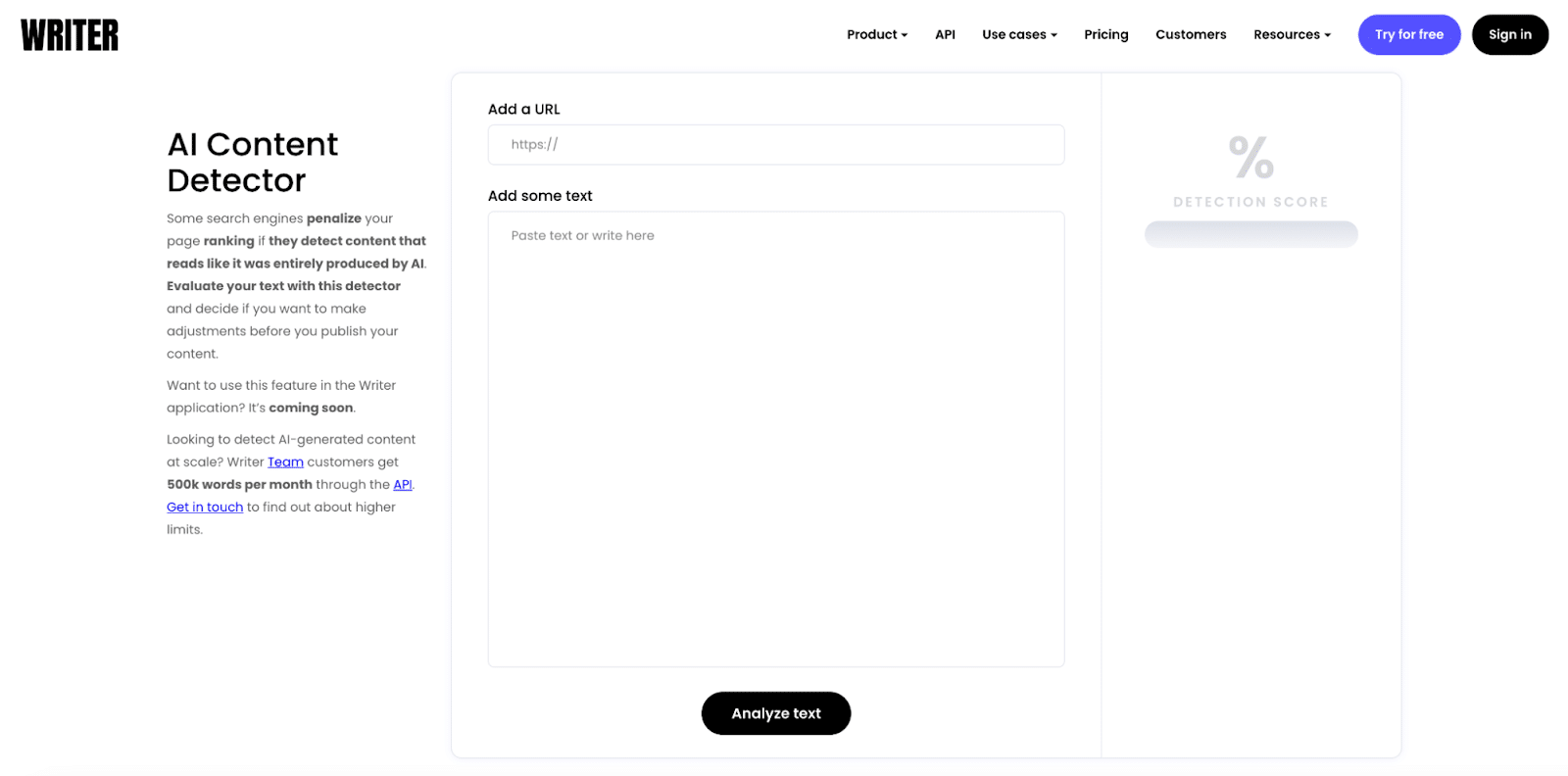
The platform has its own AI content detection tool that makes it easy to detect what content AI may have generated.
Users can add a URL or copy and paste text into the window. After clicking “Analyze Text,” the platform will provide a percentage of AI-generated copy detected in the article.
Writer will soon integrate this tool into the broader platform, making it as easy as just a few clicks to detect AI content within an article.
2. Copyleaks
Copyleaks offers a simple-to-use AI-content detector on their website.

This is a free service that can detect a wide array of AI-driven content, including pieces generated by ChatGPT, GPT3, Human, AI & Human, and more. You can also download a Chrome Extension, which can detect it on pages you’re browsing.
This is still in beta, but it is useful for anyone that needs to assess their content. The interface is easy to use, and you’ll know exactly what to do when you land on the page.
Although Copyleaks offers other services (like plagiarism detection), it isn’t a full-fledged grammar studio like some other platforms. However, it does have other tools, like an AI Grader to assess school assignments that AI may have generated.
3. Content at Scale
Content at Scale has a unique AI detector that complements its AI writing platform. The company boasts that its AI writing tool can “create non-detectable AI-generated content.”
With a statement like that, you’d expect their AI Detector to be top-notch.

The AI Detector will provide a verdict “within seconds” after submitting the content. However, this platform is a bit unique compared to the others. The platform showcases a “human content score” that is a mix of “predictability, probability, and pattern” scores.
It explains a bit more as to why the tool thinks AI generated the content. Is it because the content is too predictable, has a high probability, or has a replicable pattern? Those scores can outline the reasoning behind the overall rating.
This AI detector takes a unique approach by also providing the human aspect of it with the “Human Content Score.” Ultimately, this platform provides more ratings and insight into its view of the content, making it a top contender to select for your detection work.
4. Originality.AI
Originality.AI is unique because it is a Google Chrome extension, which makes it easy to check in real-time if AI created a page.
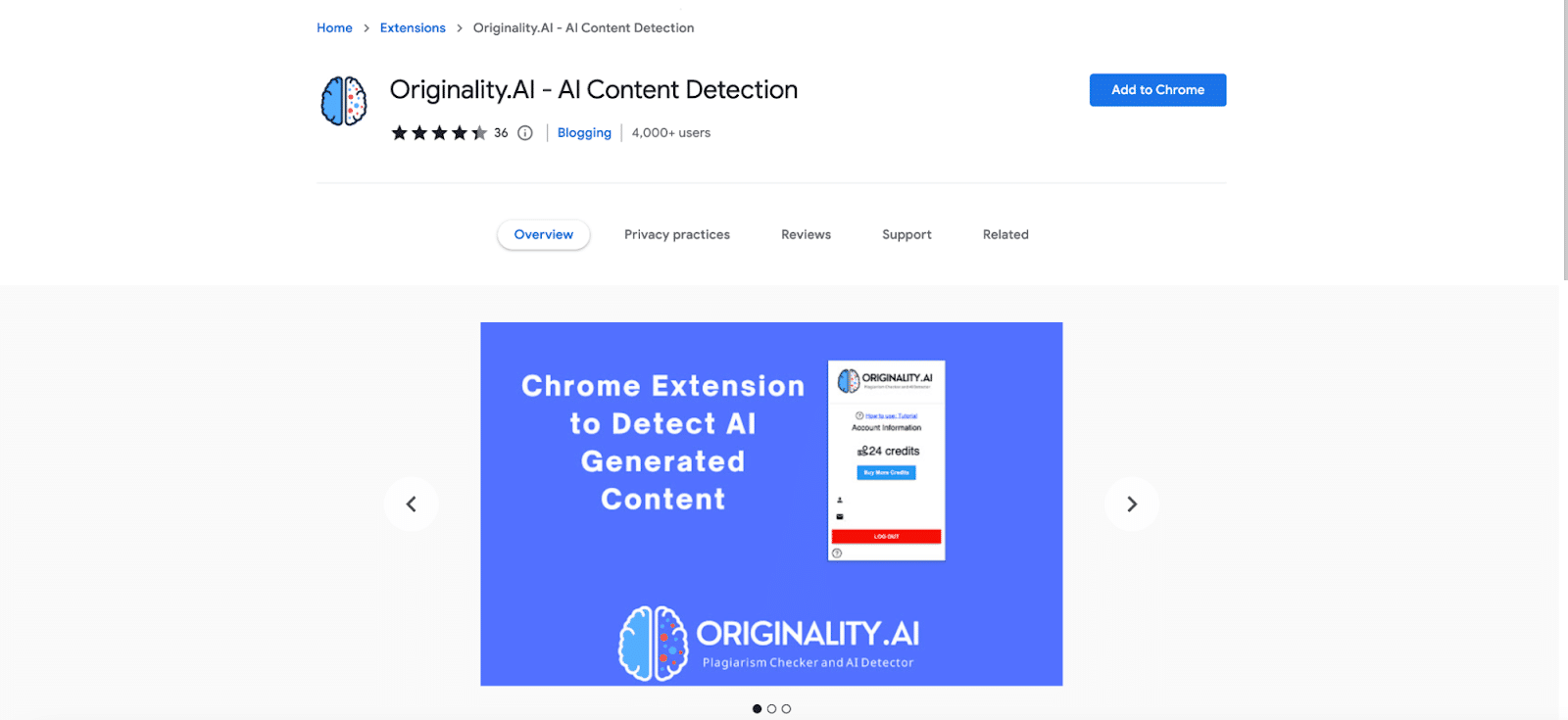
Most of the positive reviews highlighted its speed as a core value proposition. After all, you don’t have to copy and paste the content or add a URL to evaluate it.
Others who negatively scored the product did not like the prices associated with the product. Although there is a free version, many felt that there were hidden fees associated with it.
5. GPT Zero
Educators commonly use GPT Zero, but it is useful for business purposes as well.
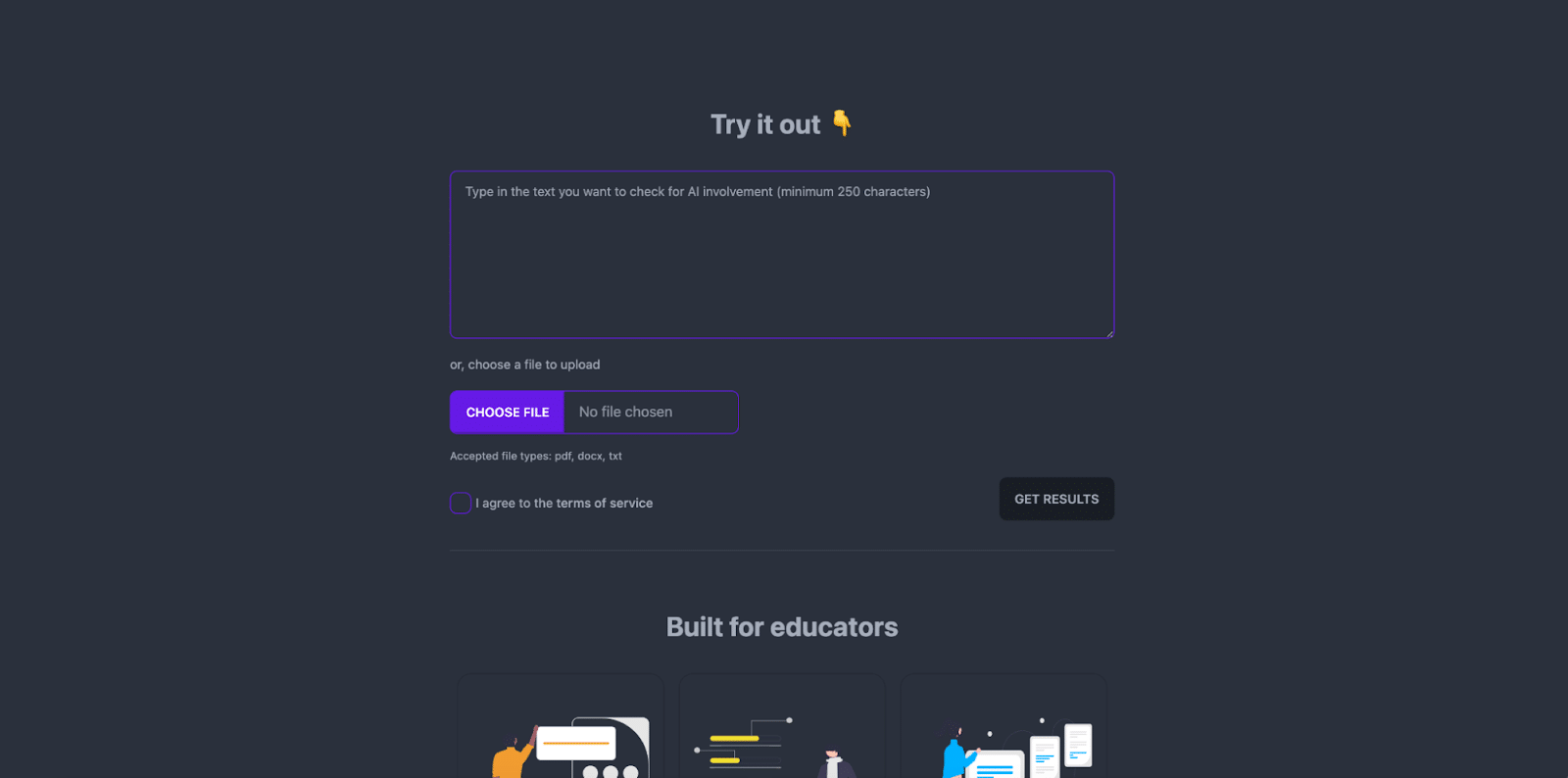
Over 1 million people have successfully used the tool to assess if AI generated their content. The interface of GPT Zero is very simple to use. It almost feels similar to Google’s homepage, where there is not a ton of content on it.
Just a simple call-to-action that says, “Try it Out,” with a box for you to input your content. All you need to do is copy and paste your article into the box on the screen, and you’ll be able to see if AI created your content.
Overall, this is a simple and quick way to check your content, but the other platforms have more sophisticated offerings than GPT Zero.
6. Sapling
Sapling, a company known for its AI modeling copilot, also offers an AI content detection tool.
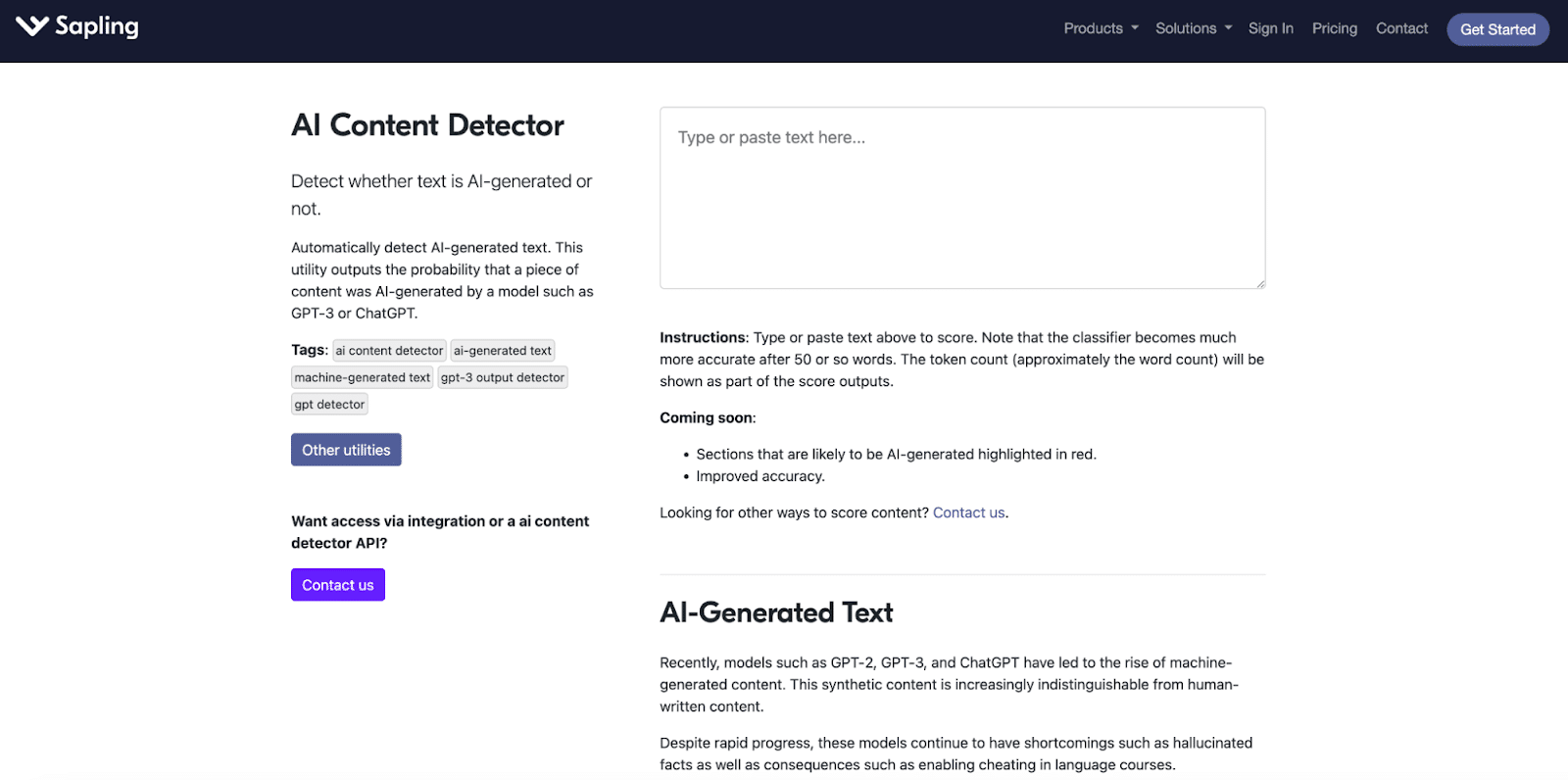
The Sapling AI content detector can detect if GPT-3 or ChatGPT wrote an article by evaluating only 50 words. This is a smaller word count that is required compared to most other content detection tools.
The best part is that the tool turns AI-generated content red and provides an overall percentage of fake content. Former researchers from Google, Berkeley, and Stanford developed the tool.
The company plans to continuously improve the AI detection function altogether, making it smarter over time.
7. Corrector App
Writers use the Corrector App to identify grammatical errors in their articles. Now, the Corrector App offers a new AI content detection tool that complements its other capabilities.
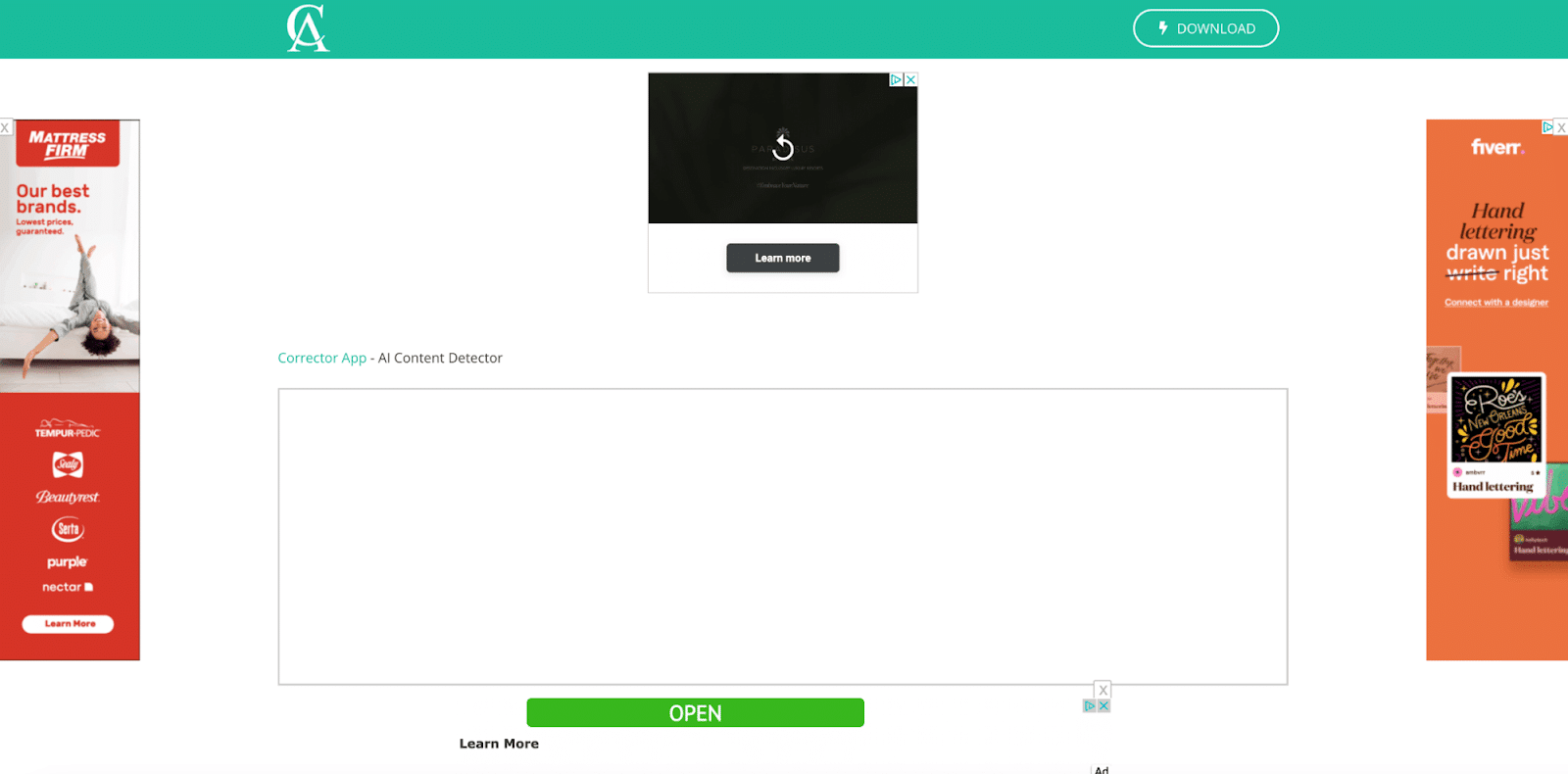
This lesser-known AI content detection tool is free for all users. The tool requires a minimum of 300 words. This might be an app you’d use for a quick check, but there are better options on the market.
Corrector App’s user experience isn’t the best in the market. The ads on the page are distracting, and the overall experience seems limited.
8. Crossplag
Crossplag is a comprehensive AI-detection tool with a few unique features that set it apart from its competitors.
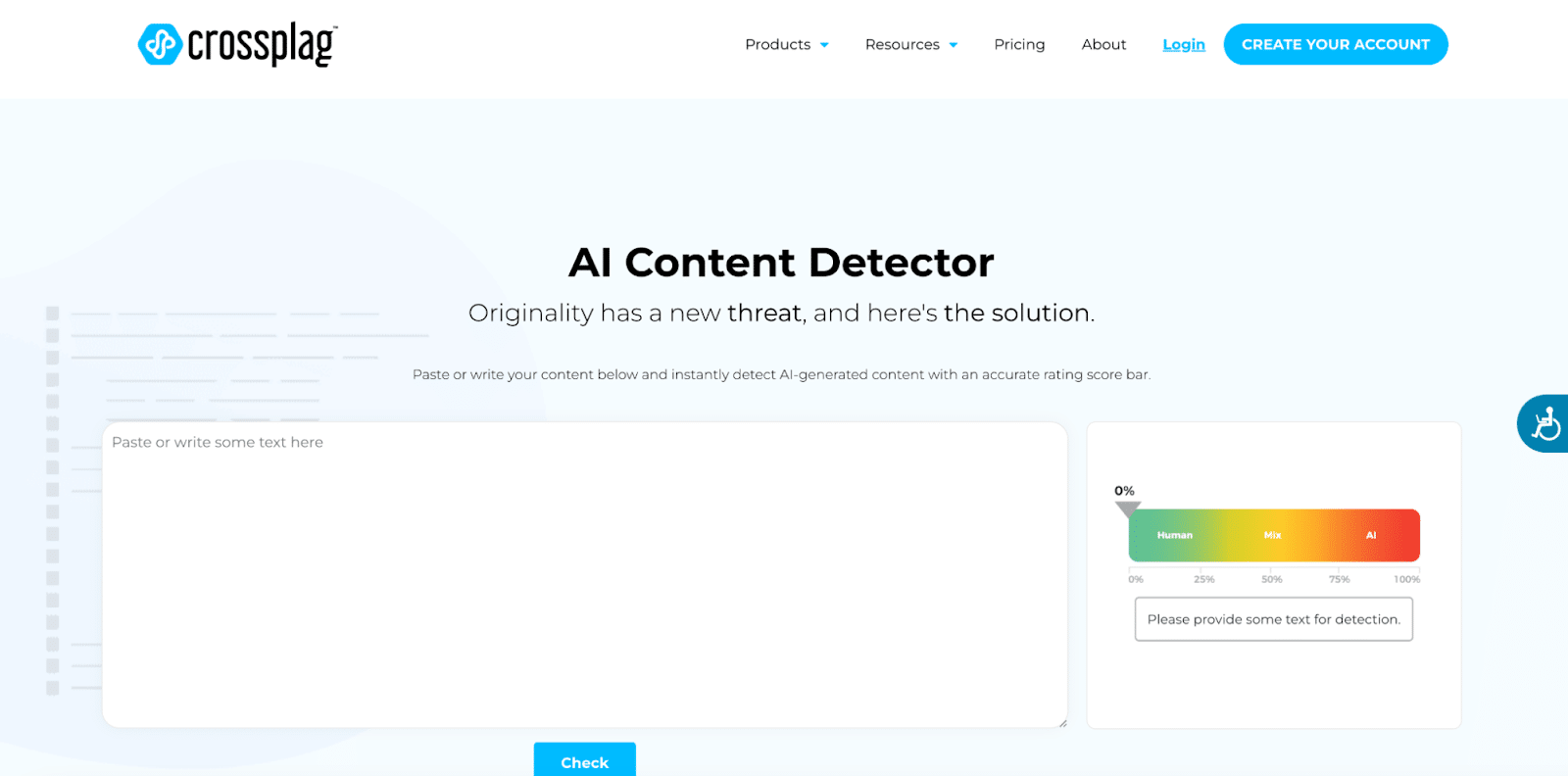
Much like other similar tools, Crossplag invites users to paste some text into the window on the screen and click the blue “Check” box. Then, it will provide an overall rating on the authenticity of the content.
The tool has a thermometer scale graphic that shows how much of the article is fake. This is unique to some of the other tools and a welcomed addition. If the thermometer stays green, it is in the clear, and a human generated most of it. If it heads to the red side, it means AI generated most of the article.
This helpful feature makes it easy to know if the content is clear for publishing.
9. AI Content Detector by SurferSEO
Surfer’s free AI content detector uses machine-learning and NLP (natural language processing) to analyse text for patterns typical of AI writing, from syntactic structure to vocabulary and sentence flow, and assigns an AI-likelihood score (on a 0–100 scale).

You can paste a section of text into the detector to check how likely it is AI-generated. For example, fully AI-generated content tends to show up with very high scores, while human-written or heavily edited text often gets lower (or “human”) scores.
Beyond detection, Surfer gives you the option to “humanize” AI-written text using its AI Humanizerm a rewrite tool that makes a text read more like natural human writing, while preserving the original meaning and SEO-relevant content. This can be handy if you want to reduce the chance of detection or make AI-assisted content more polished.
10. Kazan SEO
Kazan SEO is one of the first full-service SEO suites to offer an AI content detection tool within its platform.
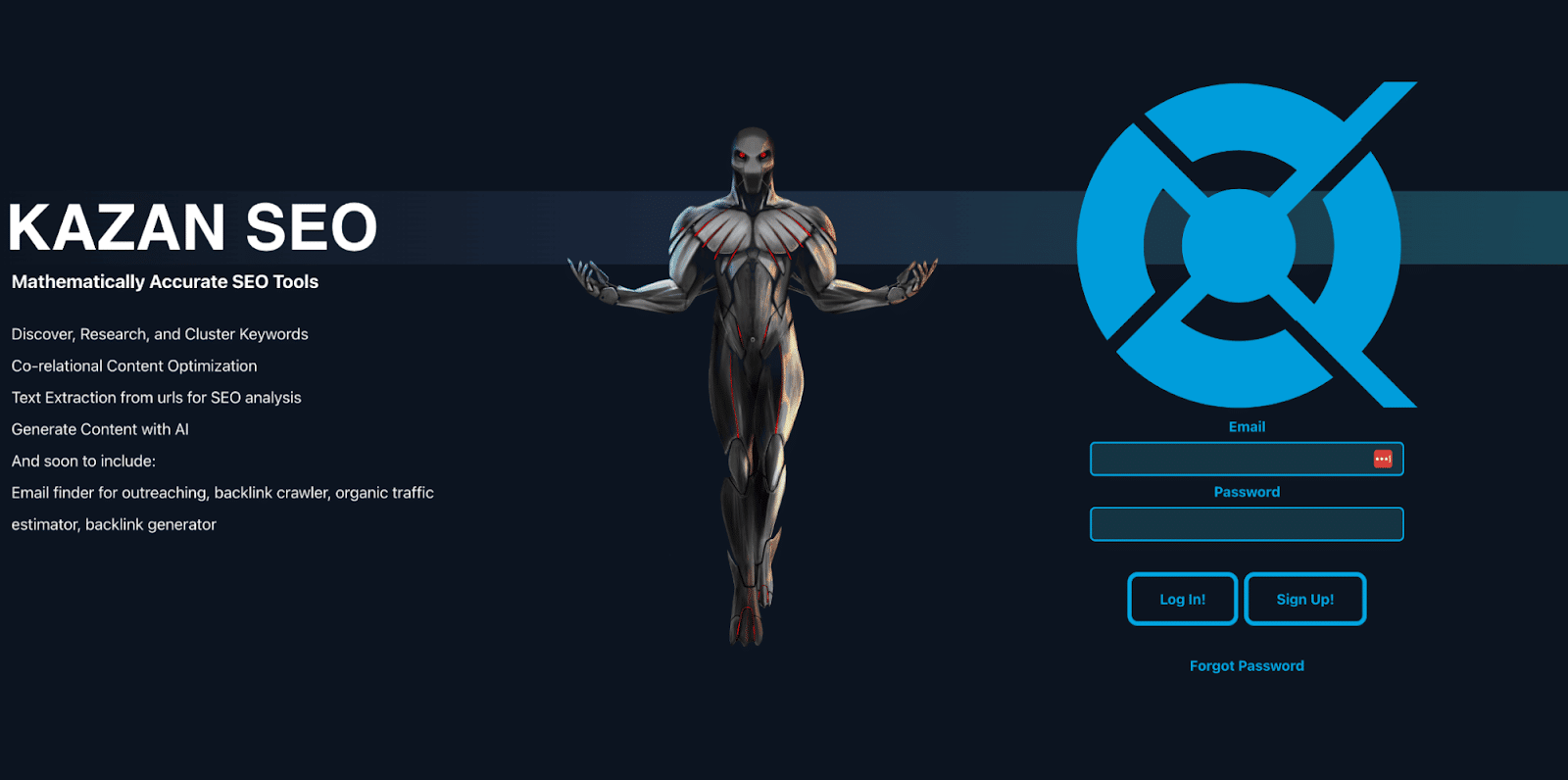
If you’re looking for a basic SEO tool as well as an AI content detection tool, Kazan SEO is a good place to start.
This free software offers a fleet of features, including keyword clusters, content optimization, text extraction, AI-content generators, and, most importantly, AI content detection.
Similar to other platforms, AI content detection is free to use and quickly determines the overall percentage of AI-generated copy in a block of content. This insight is invaluable for your overall SEO strategy, which is why it is a good idea that Kazan SEO offers the tool.
With this tool at your fingertips and Kazan’s other SEO features, you can build an impactful, authentic SEO strategy that will put you ahead of your competition.
Summary
AI-generated content is here, and you need to be ready.
Savvy marketers who are ahead of the competition will use an AI content detection tool to assess and review their content. Much like continuous optimization, AI content detection should be a routine part of the content development process for marketers.
This is a must-have for businesses that have a blog on their site. And businesses that don’t have one need to consider creating one.
The most successful sites have a content marketing engine that is continuously publishing engaging, helpful content. Businesses can increase their output of quality articles with the help of AI content tools.
Creating quality content in large volumes alone is not enough. In order to rank high on SERPs and attract quality traffic, businesses also need a good and reliable host to serve this content to their potential customers.


